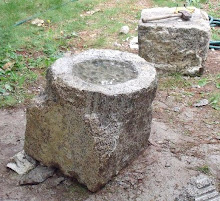A healthy natural forest is a self-sustaining system made up of a complex web of relationships. A forest gets its energy from the sun as well as through the recycling of nutrients between forest organisms and the soil. When materials from trees and animals fall to the ground they are termed forest litter. This litter in addition to dead soil organisms, minerals from rocks, and atmospheric nitrogen provide the forest with its energy needs. Soil microbes are a key link in the nutrient cycles that a forest is dependent upon for continuing vitality.
Soil microbes process the forest litter into a useable form for trees. Forest litter is initially broken down by organic acids in the soil and larger soil organisms such as earthworms, beetles, and small arthropods. By the time microbes can process the organic matter it is in the form of sugars, starches, proteins, cellulose, hemicellulose, lignin, fats, and waxes. The microbes get their energy by breaking apart carbon chains which results in the release of nitrogen and other nutrients formally locked up in the decaying organic matter or humus. This process, known as mineralization, then moves to nitrification as bacteria change ammonium into nitrite and finally into nitrate.
Forest succession is the method by which trees occupy a landscape in a natural progression of tree species while the environment is modified by the preceding population. A succession will begin after a disturbance to a forest such as a clearcut, fire, landslide, windstorm, or similar calamity. The first trees to grow and flourish will be pioneer tree species such as Red Alder, Douglas Fir, Ponderosa Pine, and Lodgepole Pines. These pioneers are adapted to survival in open areas fully exposed to the elements. As the young forest matures a more protected environment suitable to the growth of shade tolerant species emerges. Shade tolerant species include the Western Hemlock, true firs, and Western Redcedar. After some time the shade tolerant trees penetrate and dominate the forest canopy at which point the forest is said to be at climax.
Nutrient cycling involves the release of nitrogen from humus and its uptake by plants and microbes as protein. Nitrogen, a macronutrient essential for plant growth is available for plants in two forms, ammonium (NH4) and nitrate (NO3). The ammonium and nitrate are the products of mineralization of humus by microbes. The nitrogen cycle evolves as the pioneer forest gives way to the climax forest. There are many factors responsible for these changes during which the forest ecosystem moves towards a mature and stable equilibrium. Some of the changes noted are in the leaf and forest litter composition, microbial preferences for energy, and decreasing pH levels. As these changes occur trees adapted for the new habitat are favored over those who first settled it.
One of the differences between a mature forest and a forest after a disturbance is the form of nitrogen available to plants. Mature forests have more ammonium than disturbed sites, which tend to have more nitrate. That conifers prefer ammonium soils explains their predominance in the mature forests of the Pacific Northwest. In fact, some tree species cannot survive in predominately ammonium soils. When soils are high in ammonium species adapted to such levels are selected over those that prefer nitrate rich soils. The difference in nitrogen availability is a reason why species such as Red Alder and Western Hemlock do not grow in intermingled stands. The form of nitrogen available in the soil is a key in determining which tree species will thrive on a given soil.
Following a disturbance the amount of forest litter production drops dramatically. When organic matter is removed from the soil there is not enough carbon for all the microbes. When this happens the microbial activity drops off and immobilized nitrate from dead microbes is released making the soil nitrate rich. In addition the microbes "go after the ammonium which requires less energy to process". The soil now becomes depleted of ammonium and rich in nitrate opening the window for pioneer species to start the forest succession evolution again.
Another aspect of forest succession is change in the pH of the forest soil. In mature forests the litter has a high carbon to nitrogen ratio because a lot of it is woody material. High carbon to nitrogen ratios tend to "prevent the release of ammonium" and "may prevent nitrification". During nitrification bacteria oxidize the ammonium ion resulting in a loss of two hydrogen ions thereby increasing the acidity of the soil. Following a disturbance to a mature forest, soil acidity will increase which in turn decreases macronutrient availability.
Forest succession is a natural process that has evolved for a long time. When one factor in the forest succession cycle goes out of balance the other factors respond to reach equilibrium again. The fact that Western Hemlock or Western Redcedar is growing in an environment does not mean that they can be clearcut and replanted again. Pioneer tree species help the soil recover by adding carbon to the soil and building up humus to the benefit of future microbial and tree populations. By using our knowledge of natural systems and their complex web of balances we may be able to improve our timber harvesting methods particularly in habitats that are ecologically fragile and valuable.
copyright Michael Phemister
